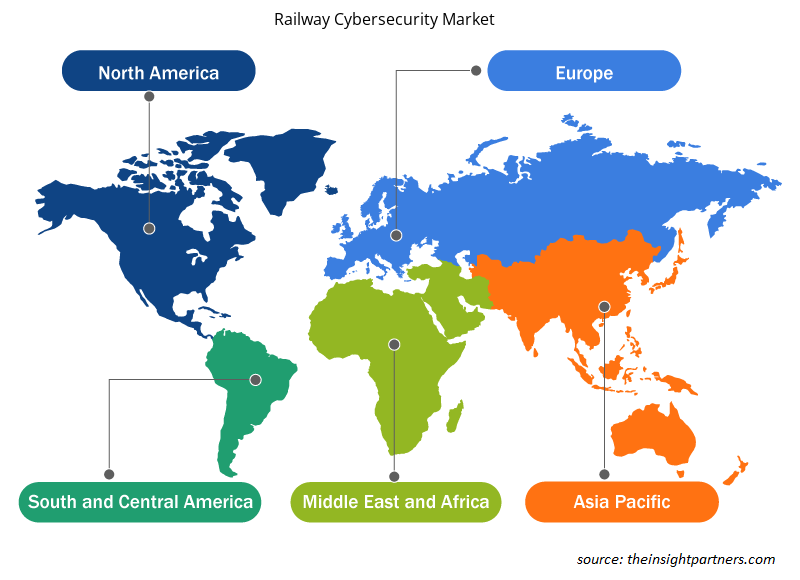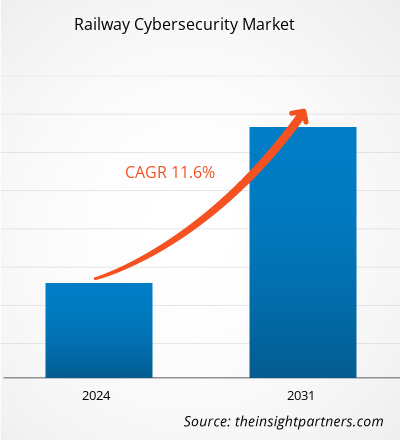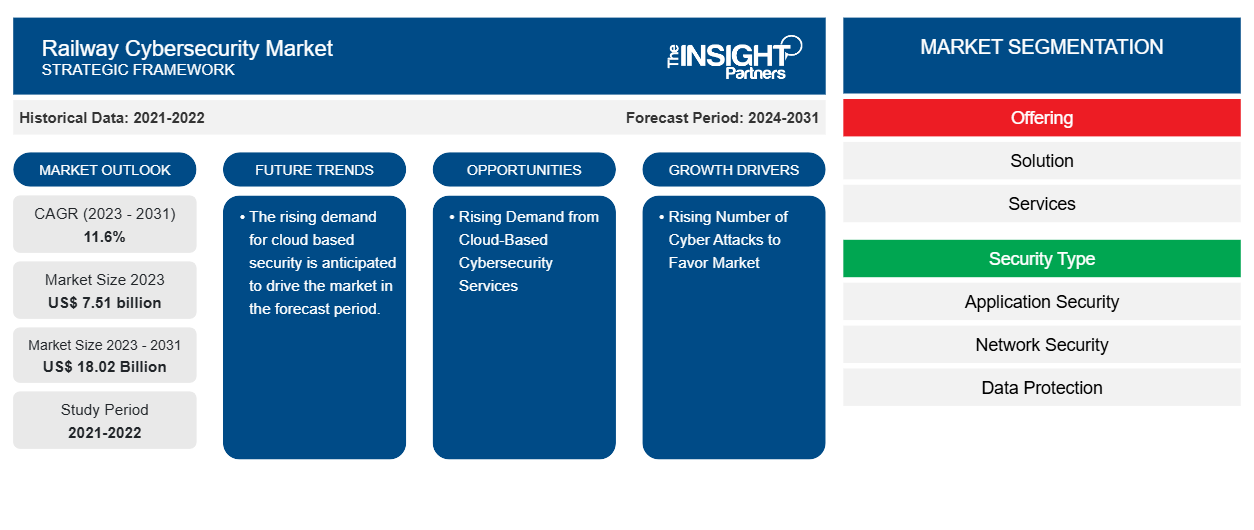Se prevé que el tamaño del mercado de ciberseguridad ferroviaria alcance los 18.020 millones de dólares en 2031, frente a los 7.510 millones de dólares en 2023. Se espera que el mercado registre una CAGR del 11,6 % durante el período 2023-2031. Es probable que el creciente número de ciberataques y la creciente adopción de soluciones de movilidad inteligente en los ferrocarriles sean los principales impulsores y tendencias del mercado.
Análisis del mercado de ciberseguridad ferroviaria
El mercado de la ciberseguridad ferroviaria está experimentando un crecimiento significativo a nivel mundial. Este crecimiento se atribuye al creciente número de ciberataques y a la creciente adopción de soluciones de movilidad inteligente en los ferrocarriles. Además, las crecientes leyes y regulaciones de ciberseguridad y la creciente demanda de servicios de ciberseguridad basados en la nube son los factores que se prevé que impulsen el crecimiento del mercado de la ciberseguridad ferroviaria en los próximos años.
Descripción general del mercado de ciberseguridad ferroviaria
La ciberseguridad en los ferrocarriles está adquiriendo una gran importancia debido a la creciente dependencia de los sistemas y tecnologías digitales. A medida que los ferrocarriles se han ido modernizando, han adoptado diversos sistemas informáticos para supervisar y controlar las operaciones, desde la señalización y la gestión de las vías hasta la gestión de pasajeros y la emisión de billetes. Esta digitalización ha hecho que los sistemas ferroviarios sean más cómodos y eficientes para los pasajeros y los operadores.
Personalice este informe según sus necesidades
Obtendrá personalización en cualquier informe, sin cargo, incluidas partes de este informe o análisis a nivel de país, paquete de datos de Excel, así como también grandes ofertas y descuentos para empresas emergentes y universidades.
-
Obtenga las principales tendencias clave del mercado de este informe.Esta muestra GRATUITA incluirá análisis de datos, desde tendencias del mercado hasta estimaciones y pronósticos.
Factores impulsores y oportunidades del mercado de la ciberseguridad ferroviaria
El creciente número de ataques cibernéticos favorece al mercado
Las infraestructuras críticas del ferrocarril están cada vez más expuestas a posibles ciberataques. La conectividad y el uso de la tecnología en todos los sectores han mejorado el servicio prestado a los ciudadanos, optimizando procesos y recursos y mejorando la calidad de las acciones de cada operador. Pero esta conectividad también tiene su lado oscuro, facilitando la actuación de actores maliciosos que puedan atacar e interrumpir el servicio correspondiente. El sector se enfrenta a varias ciberamenazas que pueden afectar significativamente a su operativa. Los principales componentes a los que podrían dirigirse los ciberataques incluyen los sistemas de control y señalización, las redes de comunicación y los sistemas de gestión del tráfico, los sistemas de información al pasajero y de emisión de billetes, así como las infraestructuras de mantenimiento y gestión de activos.
Creciente demanda de servicios de ciberseguridad basados en la nube.Cybersecurity Services.
Se prevé que la creciente demanda de servicios de ciberseguridad basados en la nube impulsará el mercado en los próximos años. Las soluciones de ciberseguridad basadas en la nube pueden ayudar en la gestión y el monitoreo automáticos de los sistemas de señalización ferroviaria. Se puede rastrear el estado de cada señal mediante sensores y cambiar y modificar automáticamente los ajustes según sea necesario. Puede ayudar a mejorar la productividad y prevenir problemas antes de que ocurran. Un sensor , por ejemplo, detectará un problema con una señal en particular al instante. Y en la nube, se realizarán cambios en tiempo real que afectarán solo a esa señal. De esta manera, los trenes pueden evitar esas señales sin demoras ni interrupciones.cybersecurity services is anticipated to drive the market in the coming years. Cloud-based cybersecurity solutions can aid in the automatic management and monitoring of railway signalling systems. One can track the status of each signal using sensors and automatically change and modify settings as needed. It can assist in enhancing productivity and prevent problems before they occur. A
Análisis de segmentación del informe de mercado de ciberseguridad ferroviariaCybersecurity Market Report Segmentation Analysis
Los segmentos clave que contribuyeron a la derivación del análisis del mercado de ciberseguridad ferroviaria son la oferta, el tipo de seguridad, el tipo y la aplicación.cybersecurity market analysis are offering, security type, type, and application.
- En función de la oferta, el mercado de ciberseguridad ferroviaria se divide en soluciones (gestión de riesgos y cumplimiento, cifrado, cortafuegos, antivirus/antimalware, detección/prevención de intrusiones y otros) y servicios. Se prevé que el segmento de soluciones ocupe una cuota de mercado significativa en el período de previsión.cybersecurity market is divided into solutions (risk and compliance management, encryption, firewall, antivirus/antimalware, intrusion detection/intrusion prevention, and others) and services. The solution segment is anticipated to hold a significant market share in the forecast period.
- Según el tipo de seguridad, el mercado de ciberseguridad ferroviaria se divide en seguridad de aplicaciones, seguridad de redes, protección de datos, seguridad de puntos finales y administración de sistemas. Se prevé que el segmento de seguridad de aplicaciones ocupe una cuota de mercado significativa en el período de pronóstico.cybersecurity market is divided into application security, network security, data protection, endpoint security, and system administration. The application security segment is anticipated to hold a significant market share in the forecast period.
- Por tipo, el mercado se segmenta en tecnología operativa (OT) y tecnología de la información (TI). Se prevé que el segmento de tecnología operativa (OT) tenga una participación de mercado significativa en el período de pronóstico.
Análisis de la cuota de mercado de la ciberseguridad ferroviaria por geografíaCybersecurity Market Share Analysis by Geography
El alcance geográfico del informe del mercado de ciberseguridad ferroviaria se divide principalmente en cinco regiones: América del Norte, Asia Pacífico, Europa, Medio Oriente y África, y América del Sur y Central.cybersecurity market report is mainly divided into five regions: North America, Asia Pacific, Europe, Middle East & Africa, and South & Central America.
América del Norte ha dominado el mercado de la ciberseguridad ferroviaria. Las tendencias de adopción de alta tecnología en diversas industrias de la región de América del Norte han impulsado el crecimiento del mercado de la ciberseguridad ferroviaria. Se espera que factores como la mayor adopción de herramientas digitales y el alto gasto tecnológico por parte de las agencias gubernamentales impulsen el crecimiento del mercado de la ciberseguridad ferroviaria de América del Norte. Además, un fuerte énfasis en la investigación y el desarrollo en las economías desarrolladas de los EE. UU. y Canadá está obligando a los actores norteamericanos a traer soluciones tecnológicamente avanzadas al mercado. Además, Estados Unidos tiene un gran número de actores del mercado de la ciberseguridad ferroviaria que se han centrado cada vez más en el desarrollo de soluciones innovadoras. Todos estos factores contribuyen al crecimiento del mercado de la ciberseguridad ferroviaria en la región.cybersecurity market. High technology adoption trends in various industries in the North American region have fuelled the growth of the railway cybersecurity market. Factors such as increased adoption of digital tools and high technological spending by government agencies are expected to drive the North American railway cybersecurity market growth. Moreover, a strong emphasis on research and development in the developed economies of the US and Canada is forcing the North American players to bring technologically advanced solutions into the market. In addition, the US has a large number of railway cybersecurity market players who have been increasingly focusing on developing innovative solutions. All these factors contribute to the region's growth of the railway cybersecurity market.
Perspectivas regionales del mercado de ciberseguridad ferroviariaCybersecurity Market Regional Insights
Los analistas de Insight Partners explicaron en detalle las tendencias y los factores regionales que influyen en el mercado de ciberseguridad ferroviaria durante el período de pronóstico. Esta sección también analiza los segmentos y la geografía del mercado de ciberseguridad ferroviaria en América del Norte, Europa, Asia Pacífico, Oriente Medio y África, y América del Sur y Central.Cybersecurity Market throughout the forecast period have been thoroughly explained by the analysts at Insight Partners. This section also discusses Railway Cybersecurity Market segments and geography across North America, Europe, Asia Pacific, Middle East and Africa, and South and Central America.

- Obtenga datos regionales específicos para el mercado de ciberseguridad ferroviaria
Alcance del informe sobre el mercado de ciberseguridad ferroviaria
| Atributo del informe | Detalles |
|---|---|
| Tamaño del mercado en 2023 | 7.510 millones de dólares estadounidenses |
| Tamaño del mercado en 2031 | US$ 18.02 mil millones |
| CAGR global (2023 - 2031) | 11,6% |
| Datos históricos | 2021-2022 |
| Período de pronóstico | 2024-2031 |
| Segmentos cubiertos |
Al ofrecer
|
| Regiones y países cubiertos |
América del norte
|
| Líderes del mercado y perfiles de empresas clave |
|
Densidad de actores del mercado de ciberseguridad ferroviaria: comprensión de su impacto en la dinámica empresarial
El mercado de la ciberseguridad ferroviaria está creciendo rápidamente, impulsado por la creciente demanda de los usuarios finales debido a factores como la evolución de las preferencias de los consumidores, los avances tecnológicos y una mayor conciencia de los beneficios del producto. A medida que aumenta la demanda, las empresas amplían sus ofertas, innovan para satisfacer las necesidades de los consumidores y aprovechan las tendencias emergentes, lo que impulsa aún más el crecimiento del mercado.
La densidad de actores del mercado se refiere a la distribución de las empresas o firmas que operan dentro de un mercado o industria en particular. Indica cuántos competidores (actores del mercado) están presentes en un espacio de mercado determinado en relación con su tamaño o valor total de mercado.
Las principales empresas que operan en el mercado de la ciberseguridad ferroviaria son:
- CAPGEMINI SE
- Sistemas Cisco, Inc.
- Aeroespacial Collins
- Marca: Hitachi
- Compañía de tecnologías Huawei
- Limitado.
Descargo de responsabilidad : Las empresas enumeradas anteriormente no están clasificadas en ningún orden particular.

- Obtenga una descripción general de los principales actores clave del mercado de ciberseguridad ferroviaria
Noticias y desarrollos recientes del mercado de ciberseguridad ferroviaria
El mercado de la ciberseguridad ferroviaria se evalúa mediante la recopilación de datos cualitativos y cuantitativos a partir de una investigación primaria y secundaria, que incluye importantes publicaciones corporativas, datos de asociaciones y bases de datos. A continuación, se enumeran algunos de los avances en el mercado de la ciberseguridad ferroviaria:
- Cylus, líder reconocido en soluciones de ciberseguridad ferroviaria, anunció un logro: su solución insignia CylusOne ha obtenido el codiciado título de ser la primera solución de ciberseguridad ferroviaria del mundo en obtener la prestigiosa certificación IEC 62443-4-2 en el nivel de seguridad 3. (Fuente: sitio web de la empresa Cylus, febrero de 2024)
- Strides International Business firmará un memorando de entendimiento (MoU) con Egis para la prestación de servicios de ciberseguridad en el sector ferroviario. (Fuente: sitio web de la empresa Strides International Business, noviembre de 2023)
Cobertura y resultados del informe sobre el mercado de ciberseguridad ferroviaria
El informe “Tamaño y pronóstico del mercado de ciberseguridad ferroviaria (2021-2031)” proporciona un análisis detallado del mercado que cubre las siguientes áreas:
- Tamaño del mercado de ciberseguridad ferroviaria y pronóstico a nivel mundial, regional y nacional para todos los segmentos clave del mercado cubiertos bajo el alcance
- Tendencias del mercado de ciberseguridad ferroviaria, así como dinámicas del mercado, como impulsores, restricciones y oportunidades clave
- Análisis detallado de las cinco fuerzas de Porter y PEST y FODA
- Análisis del mercado de ciberseguridad ferroviaria que abarca las tendencias clave del mercado, el marco global y regional, los principales actores, las regulaciones y los desarrollos recientes del mercado
- Análisis del panorama de la industria y de la competencia que abarca la concentración del mercado, el análisis de mapas de calor, los actores destacados y los desarrollos recientes del mercado de ciberseguridad ferroviaria
- Perfiles detallados de empresas
- Análisis histórico (2 años), año base, pronóstico (7 años) con CAGR
- Análisis PEST y FODA
- Tamaño del mercado, valor/volumen: global, regional y nacional
- Industria y panorama competitivo
- Conjunto de datos de Excel
Informes recientes
Informes relacionados
Testimonios
Razón para comprar
- Toma de decisiones informada
- Comprensión de la dinámica del mercado
- Análisis competitivo
- Información sobre clientes
- Pronósticos del mercado
- Mitigación de riesgos
- Planificación estratégica
- Justificación de la inversión
- Identificación de mercados emergentes
- Mejora de las estrategias de marketing
- Impulso de la eficiencia operativa
- Alineación con las tendencias regulatorias























 Obtenga una muestra gratuita para - Mercado de ciberseguridad ferroviaria
Obtenga una muestra gratuita para - Mercado de ciberseguridad ferroviaria